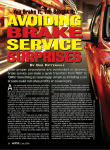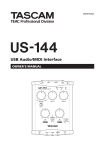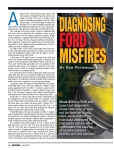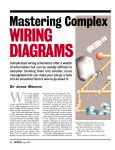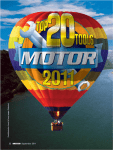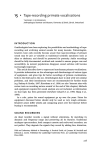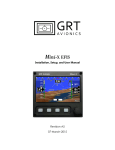Download The scan tool and digital storage oscilloscope should be considered
Transcript
O ne characteristic of a great automotive technician is the ability to perform efficient and effective diagnostics. These techs seem to know what they need to know and the tools and tests to get it. Of course, this is partly due to an accumulation of meaningful experience—experience based on real understanding. One of the skills that distinguishes an expert is a knack for finding the relevant details of his diagnostic experiences and making the “connections” and “putting the pieces together.” These abilities are what lead to an in-depth understanding of automotive systems and to “meaningful experience.” Can we do this for ourselves? Certainly. In this article, I’m going to present a fundamental framework for the basis of the behaviors that I believe will lead us to become diagnostically the best we can be. It’s based on these elements: Goal: Become the best I can be diagnostically (in the shortest amount of time). How: Learn to “put the pieces together” so I can develop an in-depth understanding of automotive systems. Mindset: I’m not going to spend my career as a go/no-go gauge dependent on others. I’m going to be a diagnostic learning machine. Perspective: Diagnostics is not just about the fix; it’s about the fix through understanding. The Tools for Success To accomplish our diagnostic tasks, it’s important to have the right tools. They are the interface between us and our ability to put the pieces together. The diagnostic tools on the top of the list are the scan tool and the lab scope. What makes these tools particularly valuable is that, when used together, they give a unique and complementary perspective of any automotive system that’s being diagnosed, right from the system’s core information pipeline—from the nuts & bolts that make up the mechanics of the system to the strategies that run it. In Fig. 1 on page 36, we can see how the scan tool and oscilloscope allow us to understand the functions of the PCM, 34 May 2013 SHARPENING YOUR MOST IMPORTANT DIAGNOSTIC TOOL BY JORGE MENCHU The scan tool and digital storage oscilloscope should be considered indispensable tools. But they can quickly become nearly worthless if the user doesn’t develop an effective way of integrating them into an overall approach to diagnostics. the circuit wiring and related circuit components. Scan Tool. We’re all familiar with the scan tool’s text, discrete values format and the smarts that come with using it. It’s a powerful tap into the brain at the center of the automotive system, giving us the software’s perspective. In general, the scan tool is certainly strong on the system strategy side and relatively weaker when it comes to the details of the mechanical side of the system. Lab Scope. A lab scope taps directly into the information and energy pipelines of the system—the circuits. A key characteristic is the extreme detail offered by the line drawing format, in which even the smallest changes can be crucial information. The result is a detailed insight into the technology’s perspective of the system. The lab scope is Photoillustration: Harold A. Perry; images: Thinkstock very strong on the technology side and relatively weaker on the strategy side. When we combine the characteristics of the scan tool and the lab scope, we discover three applicable values: They provide different perspectives of the same problem, they complement each other’s weakness and each tool extends into depths of the system where the other does not. For diagnosis, the scan tool typically is connected to a vehicle before the lab scope, and the scope is used to complement the scan data in several ways. First, it validates the values in the scan data. The scan tool interprets the information from the PCM; the PCM reports information from the circuit. The displayed values of either one can be incorrect. The waveform from the scope can be used to validate the quality and values of the signal to the PCM. The lab scope also validates expected actions. Scan data indicates a command sent to operate an actuator. Did it actually accomplish this goal? The second way the lab scope complements the scan tool is by pinpointing a problem in a circuit. While the scan tool’s code points to a problem in a circuit, the scope’s waveform pinpoints it. Take, for example, a code for a highside short in an injector circuit. A lab May 2013 35 SHARPENING YOUR MOST IMPORTANT DIAGNOSTIC TOOL Getting Your Tools Up & Running I expect almost everyone reading this article has access to or owns a scan tool. But what about a lab scope? It’s been said that we’re only as good as our greatest weakness. If you do have both a scan tool and a lab scope, it would certainly be unfortunate if the greatest weakness turned out to be the one easiest to overcome: the ability to operate them. Here are a few tips for getting started: Set up your workspace so your tools are accessible and convenient to use. If they’re not, you’re less likely to get them out when under time pressure. This is especially important for laptopbased tools. You don’t want to make a job more stressful because you haven’t figured out how to fit the tools into an active workspace. Master the “buttonology” ASAP. It’s hard to focus on a tough job when you’re trying to figure out what feature you need 36 May 2013 •Next, we gather enough additional data to fill in the blanks. •At some point, we have enough data to understand how the system works. Now let’s focus on some details, techniques and behaviors for accomplishing this. PCM Circuit Wiring Circuit Components Mechanics to access and what button to hit to get it. Master the features, too. Do you know your test equipment’s capabilities? The tool is there to give you diagnostic power; make sure you’re getting the most out of it by understanding its features and options. A key to getting over these challenges is getting your tools out before you need them. In fact, until you’re comfortable with them, get them out and use them every chance you get. During the learning process, especially with a lab scope, you’ll see mostly “known-good” waveforms. These are essential parts of your waveform analysis foundation. When you go to classes or read a case study, keep an eye out for the new diagnostic tools and learn how their features are being used. Reading the Data What do we do with the scan and waveform data once it’s in our heads? Here’s a brief outline of how we put the pieces together: •We gather data, then give it meaning by relating it to the system and other data. Thinking In Relationships Beyond comparing specs to a spec chart, the value of test data is determined by our ability to relate it to what we want to accomplish. Even advanced waveform analysis is simply the practice of making finer and more detailed relationships. So it seems that to get the most from our diagnostic experiences, it’s advisable to be in a heightened state of awareness. A good place to start is to put the word relationships at the forefront of your diagnostic thoughts. Then build on this by training yourself to ask active questions that will help guide you, such as: What can I relate this to? How does this relate? Can I relate this to that? Here are some practical examples: •How does the current in a circuit relate to the buildup of a coil’s magnetic field? •How does the 5-volt frequency signal that’s peaking only to 4.1 volts relate to the performance of the engine and the scan data? •How does this bent VRS sensor wheel relate to the waveform? •How does the block learn on a GM vehicle relate to the oxygen and mass airflow (MAF) sensors? Illustrations & waveform: Jorge Menchu scope pinpoints the exact components that are failing and confirms those that are still functioning properly. Finally, a lab scope fills in the blanks not covered by the scan tool. The PCM monitors certain aspects of the system. The lab scope can be configured to monitor almost anything; the detail of the waveform offers insights into the details of the system. For example, a scan tool reports charging voltage; a lab scope zooms in on alternator diode performance. Here’s another very powerful way to look at all of this: The PCM is connected to the rest of the vehicle only through the electrical circuits, as illustrated in Fig. 1. All of the smarts to operate the system, including the energy and information, have to go through the electrical circuits. Fig. 1 Working without either tool (scan tool or lab scope) is like working half-blind, especially when it comes to learning about the system, as well as for many diagnostic situations. Dynamic Picture To further enhance the capabilities of relationships, consider live test data as a dynamic picture of everything that’s related to it. This is especially powerful for waveforms, due to the extreme detail. Check out Figs. 2A, B and C on page 38. Each of these items helps to influence the shape of the waveform or is influenced by it. SHARPENING YOUR MOST IMPORTANT DIAGNOSTIC TOOL The waveform dynamically •What is the pathway for relates them. the information/energy/sigHere’s an example of two nal? Circuit of these relationships: •What is the input and Circuit System Components Information The static description in a output? manual of a variable relucAnother strategy is to simtance sensor: The waveform ply observe the processes PCM/ Mechanics Strategy brings it alive through its dethat occur when the system tailed and dynamic movie of is in operation. a running waveform. This is also an important Waveform: System The mechanics of the mindset specifically for diagManuals A Dynamic Behavior & Diagrams Picture & sensor includes its physical nosis. For example, a failure in Environment Movie parts and mounting: The a system means a broken waveform dynamically repprocess. Diagnosis is finding resents the integrity of the where it’s broken. A technique sensor wheel profile and for doing this is to follow the the distance of the pickup processes of operation. to the wheel. Change any Fig. 2A Here’s an example of a noof these variables and the crank on a simple starter cirThinking In Threads waveform changes. cuit, from the “learner’s” perspective: In these examples, the waveform At this point we’ve collected data and The process of turning the key results in adds to our understanding of the physi- made relationships. The next step is a running engine. But on the next start, cal parts and supplements the static de- to think in threads and/or processes, we turn the key and nothing happens. If scription in the manuals. As a result, we to gather enough pieces to reveal the we’re not familiar with the system, we not only understand the parts and sequences in which they fit and inter- could literally follow the flow of energy pieces better but we also learn their act. by following the wires—starting at the To help put this mindset into action, battery and every step of the way to the character and behavior. When you think of a waveform from ask yourself these questions: starter, perhaps—a voltage test to see if •Is what I’m observing an action or a the voltage disappears. At some point, this perspective, it’s easy to see why it has become such an important part of reaction? the broken step in the process will be •What happened before “this” and revealed—voltage in and no voltage out, learning, diagnosing and communicating…just as scan data is essential for un- what happens after? or voltage in and no action out. •Where does “this” fit in to the derstanding the strategies and the sysA Full Systems Approach process? tem’s perspective. To this point we’ve discussed the tools and how they’re used to gather data. Now, let’s wrap everything up into a “full systems approach.” The overall concept of the approach is to take advantage of the different levels of information and analyze them in the way we naturally learn. This means following the same steps an engineer uses to design a system. Fig. 2B Variable Reluctance Sensor Signal 2.7K Ohms Minimum 2V Peak-to-Peak 0V Return ECM Triggers on Falling Edge of Signal, Corresponding to Edge of Tooth Moving Away From Sensor Centerline Fig. 2C 38 May 2013 Engineer Us Develop an overview of the project. A target for our actions. Define the functional building blocks of the system. A framework to work within. A road map to guide us. Get into the details to design and build. Apply. SHARPENING YOUR MOST IMPORTANT DIAGNOSTIC TOOL A/C Switch Indicator ECM A/C ECU A/C Control Signal Engine RPM Compressor RPM Battery A/C Compressor Relay Belt Lock Controller Dual Pressure Switch ECM Simplified Circuit Diagram Compressor On/Off Refrigerant Temperature Sensor A/C Compressor Clutch Fig. 3 Target. Defining the target means developing an understanding of how the system works. This information is typically found in a service manual’s “theory of operation” and sometimes in a training module. It might include function, operation, behavior, variables, requirements and conditions. The actual target is to restore proper operation. This is vital today due to high levels of networked integration among vehicle systems. We simply don’t know what to expect because of shared data among individual vehicle systems. The question is, Do we want to learn it the costly way or the easy way? Framework. A framework is basically the mechanics of the system operation. Ideally, the information is found in a functional diagram, such as the one shown in Fig. 3 above. It’s like a wiring diagram without the detail. Ideally, it’s supplied within a system’s theory of operation. Functional diagrams typically include: •The key components involved in the function of operation, including networked devices. •The relationships of key components to each other—their placement. •The operational flow of information throughout the system—the lines and arrows. 40 May 2013 Unfortunately, functional diagrams are not always available. No problem; you can make your own. In fact, it’s worth it to reinforce these thought processes. Here’s how: 1. Bring together the “theory of operation” and a wiring diagram. 2. Pick out the main players of the system and the main variables (including the networked connections). 3. Draw boxes around the components to construct a logical layout. 4. Label each. 5. Draw arrows to show the relation- System Description Functional Diagram Wiring Diagram Test Point Test Data Fig. 4 Target Framework ships indicating the flow of information. And always identify data line connections. Road Map. The arrows of the functional diagram illustrate the basic flow of actions and information within the system. Using the road map will keep you focused and on track. Here’s how it goes for using a lab scope (Fig. 4 below): 1. We understand the theory of operation and know the diagnostic target. 2. Use the functional diagram as a guide and map for testing based on the flow of information within the system. 3. Consult the detailed information of a diagram to identify the exact test point. 4. Go to the test point on the vehicle and gather data. 5. Plug the data into your understanding of the system, which is graphically displayed in the functional diagram. 6. Repeat until done. Conclusion Let’s go back to the “turn the key and nothing happens” example (page 38), but this time from the point of view of the “expert” instead of the “learner:” The expert has already mastered the understanding of the parts and pieces of the system. He understands how the parts work together to carry out the system processes. There’s already a functional layout of the system in his mind. He doesn’t have to follow the “flow of information” from the start if he doesn’t want to. He can literally test any point in the system and still know where he is within the system processes. He understands the implication of the test results. He can quickly isolate the problem. Most of us already understand the operation of a basic starter system. If you do, too, does the above description apply to you also? If so, perhaps you know what it is to be an expert (on a particular system). You also know the rewards of true understanding, which are efficiency and effectiveness. It also means this article is about something you already do, naturally. This article can be found online at www.motormagazine.com.





